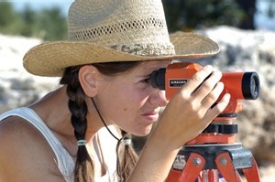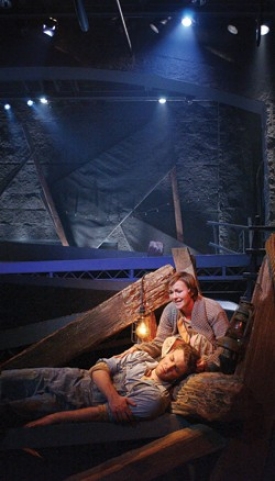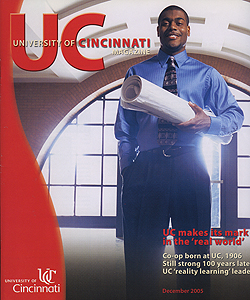Reality learning becoming UC's brand of education

Lynne Kvapil, MA (A&S) '04, shown taking advantage of reality learning on an archaeological dig in Cyprus last year. Photo/Colleen Kelley
Behind prison bars sat an innocent man. University of Cincinnati law student Mary Macpherson was convinced of it. She and fellow students had dug up evidence never presented at the original trial. They had donned hairnets and gloves to gather DNA samples not previously submitted. They photographed, videotaped and interviewed. They found an eyewitness and an accident-reconstruction expert who both disputed the original verdict. Everything pointed to a case of unjust justice.
But as gratified as Macpherson was with the application of techniques she had learned in the classroom, she realized textbooks had not prepared her for something else — the churning in her stomach. The more she believed justice was not being served, the more her emotions welled.
When the ruling came down denying inmate Chris Bennett a new trial, she "broke down," she admits. "I was astounded. The hardest thing was when Chris called from prison and I had to tell him, 'You have to stay there.' Then I had to tell his family, too."
Welcome to the real world. There's nothing quite like it. As Macpherson, Law '05, learned, "It's not 'CSI' out there."
Law students gathering evidence, testifying and notifying inmates of decisions is relatively new to the UC academic environment. So is an A&S communication student working at the White House. Or a CCM electronic media student working on the Conan O'Brien show. Or a health-education student working with the Cincinnati Reds.
Co-op students at UC figured out the importance of learning in the real world a century ago, but cooperative education simply does not fit every field of study. Consequently, the rest of the university took a little time figuring out how to embrace the concept across all disciplines.
Now, however, UC is such a proponent of "reality learning" that some form of it exists in every college and probably in every program. Co-op students may even complement their work quarters with reality-based academic quarters in which they meet CEOs in foreign countries or dream up related products for Pampers.
Reality education has become so pervasive at UC that the concept may become a pivotal recruitment tool as UC heads into the Big East athletic conference and begins recruiting students nationally. And with the backing of President Nancy Zimpher's UC|21 strategic plan, such opportunities are growing quickly.
The College of Law, for example, had offered externships for decades, but it provided the first meaningful interaction between students and real defendants in 2003 when it launched the Ohio Innocence Project to free wrongly convicted inmates. The fall of '05, the college initiated two more real-client programs.
All across campus, students are getting their hands dirty, not in simulated situations, but in real life — where lives depend on them, corporate budgets are buoyed or blasted by them, and their own nerves teach them more than textbooks ever could. The opportunities outside of co-op come through internships, practica, clinics, student teaching, fieldwork, study abroad, undergraduate research, service learning, performances and field projects.
Some experiences are mandatory; some, optional. Many students try one. Others come back for more.
Many of those opportunities may sound familiar — internships, practica and student teaching — but today's offerings differ in that they are tied more carefully to both the real world and the academic track. These experiences are faculty-led, directly related to coursework, taken for credit, often multidisciplinary and not necessarily tied to a paycheck.
Preferred reality-learning situations vary from college to college, and even from program to program within the same college, but "this is UC's brand of education," says Marianne Lewis, associate dean of innovation and program development for the College of Business. And UC does it better than any other university, she says.
Other schools have focused on one specific brand of experiential learning, maybe co-op, service learning or study abroad. "These campuses have picked one or the other and made it their hallmark," Lewis notes. "We put it all together. We are becoming the leader in reality learning."
That means students can choose between clerking for a judge or representing a client in court, between designing products for a company or conceptualizing new products to meet consumer demands. "What makes those projects so real is the client," Lewis says. "Giving students a theoretical case to work on is not the same.
"They have to hear the problem from the client, go to the client for information, then present to the client at the end. It's much more complicated when you're dealing with those constraints."
Students from several colleges work together for real-world clients
like Delta, GM and P&G

At the College-Conservatory of Music, reality learning takes place on stage. Billy Tighe and Katie Klaus portrayed Floyd Collins and his sister in the musical "Floyd Collins." Photo/Mark Lyons/courtesy of UCCollege-Conservatory of Music
When students gain real-world experience at the University of Cincinnati today, they often do so by collaborating with multiple disciplines. Teams of students from design, business and engineering, for example, work together with corporate partners on campus during academic quarters between co-op assignments.
Popular partners include Procter & Gamble, General Electric and Delta Air Lines. Last year, 50 students from industrial design and the Lindner Honors-PLUS business program formed seven teams to create a "branded experience" for Delta, one intended to differentiate it from other airlines.
One team created the "air cruise," a leisurely cruise-type experience based upon "flying from place to place" rather than sailing, management professor Ann Welsh explains. "The students worked up every bit of related collateral material, brochures to boarding passes. All aspects had to be emotionally significant and memorable for the consumer, appealing to all the senses.
"We are educating students for the creative economy," she adds. "Everything is going to be driven by our ability to create customizable experiences. It's important for students to 'get it' before they get out of here."
Multidisciplinary opportunities provide a valuable complement to co-op, says Judith Koroscik, dean of the College of Design, Architecture, Art, and Planning. "Universities slice things up into disciplines, but the real world isn't sliced up in the same way. You bring together the people who have the expertise needed.
"Increasingly, the lines are blurred in today's world, and we love to work at those blurry edges between disciplines. That's where you really can arrive at some innovative solutions."
Marianne Lewis from the College of Business shares her enthusiasm, "We've got some great biomedical-instrument projects that include engineering, medicine, business and DAAP. There are very few campuses in the world, I would argue, that truly do interdisciplinary projects like that."
What a shock
One of the most valuable lessons students learn from the multidisciplinary-team approach usually comes as a shock: "We don't think alike," states Dominic Berardi with a slight chuckle.
The fourth-year business student, who worked on the Delta project, says, "We spent nearly five weeks trying to figure out the thought process that motivates the design students. We were looking at the way they approach and solve a problem. The thought process was totally different.
"Design students wanted to go in one direction, but we wanted to know if the market segment would produce enough revenue to be worth it. We had to work through interpersonal conflicts to the point that we understood each other.
"The biggest thing was a creative synergy that came at the end. A lot of it erupted from the tension between us."
Lewis loves watching that interaction. "They learn as much about developing a product as they do about working together. Working together is very hard when you come from different departments, but that's exactly what they'll do in the workforce."
Interdisciplinary teamwork is one way corporate collaborations differ from traditional co-op, but another aspect is how much creative freedom students receive. Berardi and team members from industrial design, fashion design, marketing and mechanical engineering are currently working for General Motors, "talking about automotive solutions for 50 years from now," he says.
"There are no creative constraints. We're thinking completely outside the box, and we're being treated like we're consultants."
The students love the excitement and the challenge. "The interdisciplinary interaction is cutting-edge pedagogy," Berardi says. "I think it's a huge point of differentiation from other universities."
UC and its students aren't the only ones thrilled with the collaborations. Corporate partners have much to gain.
"Students have very fresh ways of looking at things," says Craig Vogel, director of DAAP's Center for Design, Research and Innovation. "They can give you a perspective you can't get from people who have worked in a company for 30 years.
"When you bring a project into a school and put 30 students to work on it, that's a very different environment — one where they are not worried about producing economic return in the short term. You're looking at a much richer, purer educational experience."
At the same time, working with companies keeps UC abreast of the latest innovations in the field. "We need to bring fresh ideas into our teaching," Vogel says.
"As universities look to shift the way they teach and companies look for resources to expand their capabilities, there is a real opportunity. We can be a noncompetitive complement to what a company does."

Earning academic credit by exploring old lava flows of Hawaiian volcanoes in 2002, Keri Craven, MS (A&S) '03, was testing geological theories she initially studied in class. Photo/Lisa Ventre
Internships, service learning
Corporate collaborations, of course, are only one kind of experiential learning at the University of Cincinnati. Another form that benefits nonprofit organizations instead of commercial ones is service learning.
Students in the College of Allied Health Sciences provide therapy to stroke survivors with severe communication disorders. They tutor in health courses and conduct hearing, speech and language clinics at Woodward High School. They give nutrition presentations at inner-city schools. The college probably leads the university in what it frequently calls community-engaged scholarship.
"It's the intersection of service and learning," says Jo-Anne Prendeville, MS (Ed) '78, EdD '91, CAHS associate professor and co-chair of the Service Learning Advisory Board. In all cases, projects are anchored to the curriculum and serve an unmet need in the community.
Although service learning sounds like a glorified name for volunteerism, the classroom experience strategically sets it apart, emphasizes Maggie Stevens, experiential-learning program director for the McMicken College of Arts and Sciences. "They're going out and testing theories they've learned in the classroom," she says. "Then they come back into the classroom and interact with their peers and their professors, synthesizing that information instead of just reading about it."
Child-psychology students work with Big Brothers and Big Sisters, for example, then go back to the classroom to explain which techniques worked and which didn't. "They can say, 'This theory was created 50 years ago by a white psychologist who studied white suburban children, and we're working with African-American inner-city youth from single-parent homes. There's no way this applies to them because of all these other factors.'
"It's a lot more meaningful than memorizing information for a test," Stevens says.
For A&S students, a big advantage of reality learning is the way it promotes liberal arts degrees. That is a key reason Dean Karen Gould has been promoting it since arriving on campus four years ago.
"One of our important goals is to help our students and their parents understand the practical value of a liberal arts-and-sciences education," she says. "One of the places where they can see this value implemented is in the real world. We can help our students realize the practical applicability of an arts-and-science education before they graduate."
Today is different
Internships are the most frequently used form of reality learning at the College of Arts and Sciences, and the communication program has the most activity — finding avenues for students to report on the news, handle public relations and even work at the White House. At the College-Conservatory of Music, electronic media requires internships — letting students experience radio and television broadcasting at ESPN, CNN, CBS and other stations.
In the early years, electronic media division chair Manfred Wolfram arranged internships for individual students, but now they creatively dig up their own and simply seek approval. In the fall, he gave a nod to a junior who had spent the entire summer at Paramount Studios in L.A., then moved across the country to start a gig that he personally had lined up on "Late Night with Conan O'Brien."
"This is what you want," Wolfram says. "You want the students to take the ball and run with it. All I basically have to say is, 'Don't falter. Don't run too fast. Don't forget about your academics.'"
Despite internships, reality learning is an integral part of CCM in a way different from other UC colleges. CCM is renowned for its 1,000 live public performances a year, the largest single source of performing-arts presentations in the state.
"It's fair to say CCM's whole curriculum is experience based," Dean Doug Lowry says. "Learning to create a themed theatrical environment that includes the audience is part of the curriculum."
And a live audience is the only way that can be accomplished. "In order to transmit an artistic impulse successfully, you have to learn how to plug that into the mind and ears of an audience," the dean explains. "I know of no performance artist who simply spent four years in the practice room and never learned how to present."
Similarly, no one ever learned to teach without going into a real classroom full of students. Consequently, it's no surprise that all teacher-licensure programs have major field components, but placements for some programs in the College of Education, Criminal Justice, and Human Services (CECH) are rather intriguing.
The undergraduate athletic training program has placed students with the Bengals, Reds and UC's own Bearcats, while the criminal justice program has offered field experience with federal marshals and Talbert House's substance-abuse treatment programs, says Nelson Vincent, CECH associate dean and field service assistant professor. Even online distance learning programs in educational leadership require an internship.
Fortunately, UC's strong co-op structure provides a firm basis from which to start. The benefits of real-world experience are evident across campus, and a solid foundation of corporate relationships has already been laid. The rest just keeps sprouting.
Now comes the tricky part: trying to catalog all the reality learning opportunities on campus and use them as an example of how the University of Cincinnati offers a different type of education, one that is unavailable elsewhere. "Let's make it clear to people," says Lewis, who has been charged with overseeing a campus group to do just that.
"We need to make sure it doesn't sound like a few of us saying, 'This is what we should do.' We want to say, 'This is what we do.' Let's really make it distinctive, special and shout it from the rooftops. We need to get the message clarified."
Many voices agree. "We're doing something world class," the College of Business's Ann Welsh says. "I don't know other schools offering this kind of work at an undergraduate level."
"The No. 1 issue with reality learning is transformation," Lewis adds. "We take a student further from the time they begin to the time they graduate than any other university, because they've had a series of pivotal, transformational experiences. Our goal is to truly transform students.
"We are the leader in reality learning. Now, we've got to be able to prove it."
Social justice fuels law students' work
CCM student hobnobs with artists
Faculty major key to "real world" programs
Links:
UC's experiential learning opportunities
UC law students on A&E network
Business students create Delta "experience"
Center for Design, Research and Innovation
Lindner Honors-PLUS business program
Ohio Innocence Project:

